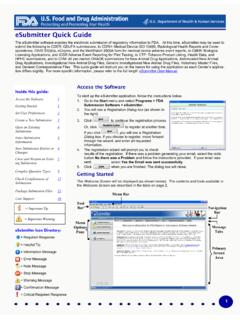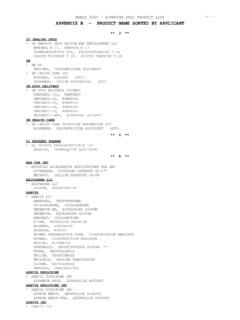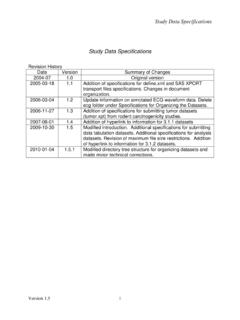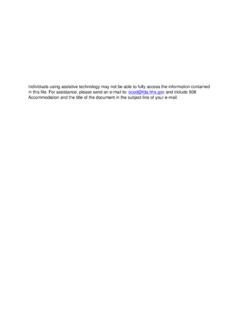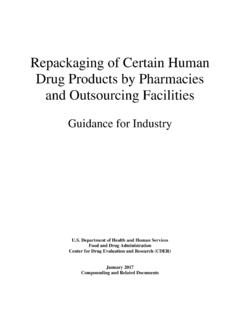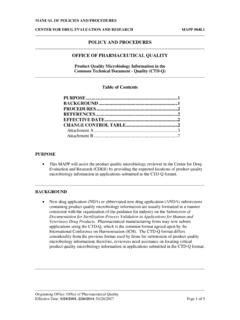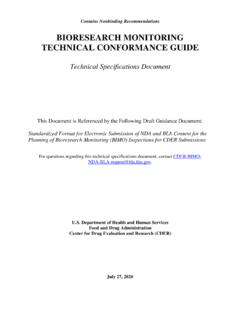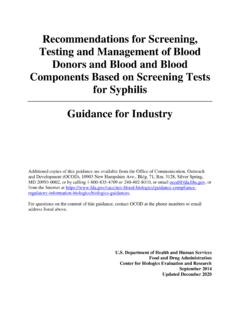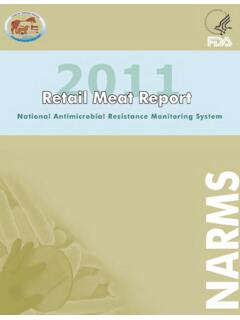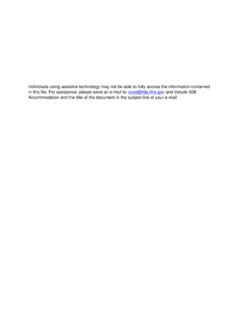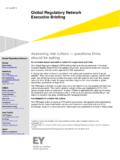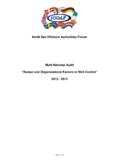Transcription of Advancing Regulatory Science at FDA: A Strategic Plan ...
1 A Strategic PLANAUGUST DEPARTMENT OF HEALTH AND HUMAN FOOD AND DRUG ADMINISTRATION Advancing Regulatory Science at FDAA Strategic PLANAUGUST Regulatory Science at SUMMARY STATEMENT PRIORITY AREAS 71. Modernize Toxicology to Enhance Product Safety 72. Stimulate Innovation in Clinical Evaluations and Personalized Medicineto Improve Product Development and Patient Outcomes 103. Support New Approaches to Improve Product Manufacturing and Quality 144. Ensure FDA Readiness to Evaluate Innovative Emerging Technologies 165. Harness Diverse Data through Information sciences to Improve Health Outcomes 206. Implement a New Prevention-Focused Food Safety System to Protect Public Health 237. Facilitate Development of Medical Countermeasures to Protect Against Threatsto and Global Health and Security 268. Strengthen Social and Behavioral Science to Help Consumers and ProfessionalsMake Informed Decisions about Regulated Product OF A STRONG Regulatory Science CULTURE AND INFRASTRUCTURE: IMPLEMENTATION STRATEGIES FOR THE Strategic PLAN FOR Regulatory Science 36 COVER PHOTO:DNA test sequencing for scienctific Food and Drug Administration / Advancing Regulatory Science at FDA 2 FDA was created in 1906 as one of our nation s principal consumer product protection agencies and is now responsible for assuring the safety of biologics, such as blood products and vaccines, drugs, medical devices, foods, cosmetics, and many other consumer goods.
2 Since 2009, it has also been responsible for regulating the manufacture, marketing, and distribution of tobacco products. In the , FDA-regulated products account for about 25 cents of every dollar spent by American consumers each year products that touch the lives of every American every day. FDA is responsible for Advancing the public health by helping to speed innovations that make foods safer and make medicines and devices safer and more effective. At the same time, FDA helps consumers and health care providers get the accurate and Science -based information they need to make the best possible decisions about their use of medical products and foods for human and non-human animal use. FDA must make decisions based on the best available scientific data and using the best tools and methods available in order to ensure products meet the highest quality standards for consumers, while at the same time fostering and Advancing innovation in the products it core responsibility of FDA is to protect consumers by applying the best possible Science to its Regulatory activities from pre-market review of efficacy and safety to post-market product surveillance to review of product quality.
3 In the last few years, rapid advances in innovative Science have provided new technologies to discover, manufacture and assess novel medical products, and to improve food safety and quality; FDA must both keep pace with and utilize these new scientific advances in order to accomplish its mission to protect and promote the health of our s Strategic Plan for Regulatory Science To meet this need, FDA has developed a Strategic plan for Regulatory Science , the Executive SummaryThe Food and Drug Administration (FDA) protects and promotes the health and safety of all Americans through enhancing the availability of safe medical products and foods and promoting innovation that addresses unmet medical and public health needs. FDA also protects and promotes the health and safety of animals through assuring the availability of safe animal drug products and food. FDA is a Science -based Regulatory agency, and a critical component to the success of the nation s public health, health care systems, and Food and Drug Administration / Advancing Regulatory Science at FDA 3science of developing new tools, standards, and approaches to assess the safety, efficacy, quality, and performance of FDA-regulated products.
4 This plan identifies eight priority areas of Regulatory Science where new or enhanced engagement is essential to the continued success of FDA s public health and Regulatory mission. The priority areas are:1. Modernize Toxicology to Enhance Product Safety2. Stimulate Innovation in Clinical Evaluations and Personalized Medicine to Improve Product Development and Patient Outcomes3. Support New Approaches to Improve Product Manufacturing and Quality4. Ensure FDA Readiness to Evaluate Innovative Emerging Technologies5. Harness Diverse Data through Information sciences to Improve Health Outcomes6. Implement a New Prevention-Focused Food Safety System to Protect Public Health7. Facilitate Development of Medical Countermeasures to Protect Against Threats to and Global Health and Security8. Strengthen Social and Behavioral Science to Help Consumers and Professionals Make Informed Decisions about Regulated Products FDA will apply available resources to implement the Strategic Plan for Regulatory Science through management of scientific programs within FDA and engagement of collaborators and partners in industry, academia and government.
5 FDA s Strategic Plan for Regulatory Science is designed to allow the Agency both to meet today s public and animal health needs and to be fully prepared for the challenges and opportunities of tomorrow to help harness revolutions in Science that can be translated into products that help make and keep our nation both safe and healthy. FDA s Strategic plan is designed to allow the Agency both to meet today s public health needs and to be fully prepared for the challenges and opportunities of Food and Drug Administration / Advancing Regulatory Science at FDA 4 IntroductionThe complexity of FDA s Regulatory and public health portfolio is growing rapidly, in large part due to scientific challenges inherent in evaluating a new generation of products based on quickly evolving Science and technology. Layered on this are the realities of an expanding global economy that requires FDA to evaluate and manage risks associated with a vast array and volume of Regulatory data, products, and ingredients produced in a multitude of global locations.
6 New drugs, biologics and medical devices are increasingly complex in their development, manufacture, and evaluation. Sophisticated global markets move foods from foreign farms to supermarkets with increasing speed. Finished products may contain a complicated array of ingredients and components, all sourced from shifting global commodities markets and often of uncertain provenance. The addition of tobacco products to FDA s Regulatory responsibilities poses new Regulatory challenges in need of new scientific solutions to better protect the public from harm. In addition, improved information technology capacity provides opportunities to harness the substantial data resources both within and external to FDA for Regulatory challenges of modern product development and globalization underscore the critical importance of modernizing and Advancing Regulatory Science to match advances in basic and applied Science and technology. Clearly, for scientific advances to realize their full potential for improving public health, FDA must be able to issue clear guidance, play a major role in the improvement of modern product and process FDA is responsible for assuring the safety of foods, drugs, medical devices, biologics such as vaccines, blood products, cell and gene therapy products, and tissues cosmetics, and many other consumer goods, as well as foods and drugs for animals.
7 Since 2009, it has also been responsible for regulating the manufacture, marketing, and distribution of tobacco products. FDA is also responsible for Advancing the public health by helping to speed innovations that provide our nation with safe and effective medicines and devices and keep our food supply safe, while helping Americans get the accurate, Science -based information they need to use medical products and consume foods to improve and maintain their Food and Drug Administration / Advancing Regulatory Science at FDA 5development tools, and make sound Regulatory decisions about risks and benefits of products that increasingly involve new technologies. To help meet these challenges, FDA has developed this Strategic Plan for Regulatory Science , the Science of developing new tools, standards, and approaches to assess the safety, efficacy, quality, and performance of FDA-regulated products. This work builds upon the white paper Advancing Regulatory Science for Public Health1 and the FDA Strategic In this work, FDA identifies priority areas where new or enhanced investments in Regulatory Science research capacity will be essential to continued mission success and to public health and safety.
8 FDA will accomplish this plan by applying its knowledge base, laboratories, scientific computing capabilities, and expertise, while leveraging resources and collaborating with domestic and international partners in government and academia. Where appropriate, FDA will also engage stakeholders from the private sector in this effort. FDA will use this plan to ensure that its Regulatory Science programs focus on the identified priorities, in combination with Center-specific approaches, but will also revisit these priorities regularly and seek public input to address evolving challenges, opportunities and changes in the Science and innovation landscape. 1. Advancing Regulatory Science for Public Health accessible at: FDA Strategic Priorities accessible at: identifies priority areas where new or enhanced investments in Regulatory Science research capacity will be essential to mission success and to public health and safety. FDA will advance Regulatory Science to speed innovation, improve Regulatory decision-making, and get safe and effective products to people in need.
9 21st Century Regulatory Science will be a driving force as FDA works with diverse partners to protect and promote the health of our nation and the global Food and Drug Administration / Advancing Regulatory Science at FDA 7 Science Priority Areas FDA has identified eight priority areas where new or enhanced engagement in Regulatory Science research is essential to Advancing its Regulatory mission. These priority areas are not restricted to one product area; rather, they address cross-cutting needs and opportunities that typically extend across several product areas where benefits and engagement from Regulatory Science successes will enhance product development, evaluation and health outcomes related to multiple products and populations. FDA s Strategic plan for Regulatory Science is critical to the continued success of the Agency in meeting its Regulatory mission and facilitating the translation of breakthrough discoveries into innovative, safe and effective products of testing serves a fundamental role in characterizing the potential risks associated with new FDA-regulated products.
10 However, serious and sometimes rare and unexpected adverse events may be observed in clinical trials or post-approval, suggesting that critical gaps exist in our understanding of the relationship between patient response and preclinical toxicology findings. For example, non-clinical safety assessment is often conducted in normal healthy test systems and tends to be exposure-based; it does not attempt to evaluate the possible risk of rare or idiosyncratic responses that may arise from potential interactions with the presence or progression of disease or the genetic background or other exposures of patients and consumers. Also, in some cases, the true predictive accuracy of many toxicology models and safety assays remains uncertain and in need of more rigorous validation against actual human and animal adverse event data to define their reliability and possible limitations. For tobacco products, a deeper understanding of the negative effects of tobacco constituents and how best to measure and, wherever possible, reduce those effects is needed to assess public health impact.
